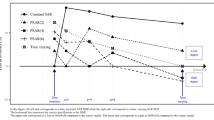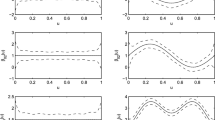Abstract
In time series context, estimation and testing issues with autoregressive and moving average (ARMA) models are well understood. Similar issues in the context of spatial ARMA models for the disturbance of the regression, however, remain largely unexplored. In this paper, we discuss the problems of testing no spatial dependence in the disturbances against the alternative of spatial ARMA process incorporating the possible presence of spatial dependence in the dependent variable. The problems of conducting such a test are twofold. First, under the null hypothesis, the nuisance parameter is not identified, resulting in a singular information matrix (IM), which is a nonregular case in statistical inference. To take account of singular IM, we follow Davies (Biometrika 64(2):247–254, 1977; Biometrika 74(1):33–43, 1987) and propose a test procedure based on the supremum of the Rao score test statistic. Second, the possible presence of spatial lag dependence will have adverse effect on the performance of the test. Using the general test procedure of Bera and Yoon (Econom Theory 9:649–658, 1993) under local misspecification, we avoid the explicit estimation of the spatial autoregressive parameter. Thus our suggested tests are entirely based on ordinary least squares estimation. Tests suggested here can be viewed as a generalization of Anselin et al. (Reg Sci Urban Econ 26:77–104, 1996). We conduct Monte Carlo simulations to investigate the finite sample properties of the proposed tests. Simulation results show that our tests have good finite sample properties both in terms of size and power, compared to other tests in the literature. We also illustrate the applications of our tests through several data sets.







Similar content being viewed by others
References
Anselin L (1988) Spatial econometrics: methods and models. Kluwer Academic Publishers, Dordrecht, The Netherlands
Anselin L (2003) Spatial externalities, spatial multipliers, and spatial econometrics. International Regional Science Review 26(2):153–166
Anselin L, Bera AK, Florax R, Yoon MJ (1996) Simple diagnostic tests for spatial dependence. Regional Science and Urban Economics 26:77–104
Baltagi B, Liu L (2011) An improved generalized moments estimator for a spatial moving average error model. Econ Lett 113:282–284
Behrens K, Ertur C, Koch W (2012) ‘Dual’ gravity: Using spatial econometrics to control for multilateral resistance. J Appl Econom 27:773–794
Bera AK, Yoon MJ (1993) Specification testing with locally misspecified alternatives. Econom Theory 9:649–658
Davidson R, MacKinnon JG (1987) Implicit alternatives and the local power of test statistics. Econometrica 55:1305–1329
Davies RB (1977) Hypothesis testing when a nuisance parameter is present only under the alternative. Biometrika 64(2):247–254
Davies RB (1987) Hypothesis testing when a nuisance parameter is present only under the alternative. Biometrika 74(1):33–43
Fingleton B (2008) A generalized method of moments estimator for a spatial model with moving average errors, with application to real estate prices. Empiri Econ 34:35–57
Florax RJGM (1992) The University: A Regional Booster? : Economic Impacts of Academic Knowledge Infrastructure, Aldershot, Hants, England and Brookfield. Vt, USA
Harrison D, Rubinfeld DL (1978) Hedonic housing prices and the demand for clean air. J Environ Econ Manag 5:81–102
Kelejian HH, Prucha IR (2001) On the asymptotic distribution of the Moran I test statistic with applications. J Econom 104(2):219–257
Lam C, Souza PCL (2013) Regularization for spatial panel time series using adaptive Lasso. Mimeo, New York
Pace RK, Gilley OW (1997) Using the spatial configuration of the data to improve estimation. J Real Estate Financ Econ 14:333–340
Poskitt DS, Tremayne AR (1980) Testing the specification of a fitted autoregressive-moving average model. Biometrika 67(2):359–363
Saikkonen P (1989) Asymptotic relative efficiency of the classical tests under misspecification. J Econom 42:351–369
Sen M, Bera AK, Kao YH (2012) A Hausman test for spatial regression model. In: Baltagi BH, CR Hill, Newey WK, White HL (eds) , vol 29. Advances in econometrics. Essays in honor of Jerry Hausman. Emerald Group Publishing Limited, Bingley, pp 547–559
Sharpe K (1978) Some properties of the crossings process generated by a stationary chi-squared process. Adv Appl Probab 10:373–391
Silvey SD (1959) The lagrange multiplier test. Ann Math Stat 30:389–407
Yao Q, Brockwell PJ (2005) Gaussian maximum likelihood estimation for ARMA models I: time series. J Time Ser Anal 27(6):857–875
Yao Q, Brockwell PJ (2006) Gaussian maximum likelihood estimation for ARMA models II: spatial processes. Bernoulli 12(3):403–429
Author information
Authors and Affiliations
Corresponding author
Appendices
Appendices
1.1 A score functions
The model we consider is
and the log-likelihood function is
where \(\theta =(\beta ',\sigma ^2,\rho ,\tau ,\lambda )\) and \(A=I-\rho W\), \(B=I-\tau W\), \(C=I-\lambda W\).
The first derivatives are
Under \(H_0: \tau =\lambda \), we have \(B=C\) and hence
Moreover, if we put \(\rho =0\), then we have \(A=I\) and under \(H_0\), the above becomes
1.2 B information matrix
From the previous section, the second derivatives of the log-likelihood function are
Therefore, the information matrix can be derived as
where
Under \(H_0:\tau =\lambda \), we have \(B=c\), and hence (B.1) becomes
where the partition matrices are


When \(\tau =\lambda \) and \(\rho =0\), we further have \(A=I\) and notice that \(tr(W)=0\). Therefore (B.2), reduces to
where
1.3 C derivation of test statistics
We first derive adjusted RS test statistic assuming \(\lambda \) is given. Defining \(\underline{\theta }=(\beta ', \rho , \tau , \sigma ^2)'\), the log-likelihood can be rewritten as
And for a given value of \(\lambda \), the score functions under joint null are
The information matrix under the null when \(\rho =0\) and \(\lambda \) is given, denoted as \(I(\underline{\theta }|\lambda )|_{H_0}\), can be derived as
Denoting \(\gamma =(\beta ', \sigma ^2)\), the standard RS test on \((\gamma ,0,\tau )\) given \(\lambda \), has the form
where
using (C.2), and the standard RS test statistic for fixed \(\lambda \) can be derived as
Now we consider the RS test adjusted for the presence of \(\rho \). Assuming \(\lambda \) given, the adjusted RS test statistic, denoted by \(RS^*_{\tau }(\lambda )\) has the form
where
Using (C.2), we have
where \(M=I-X(X'X)^{-1}X'\), and hence the adjusted RS statistic for fixed \(\lambda \) can be derived as
where
Rights and permissions
About this article
Cite this article
Kao, S.YH., Bera, A.K. Testing spatial regression models under nonregular conditions. Empir Econ 55, 85–111 (2018). https://doi.org/10.1007/s00181-018-1455-2
Received:
Accepted:
Published:
Issue Date:
DOI: https://doi.org/10.1007/s00181-018-1455-2




